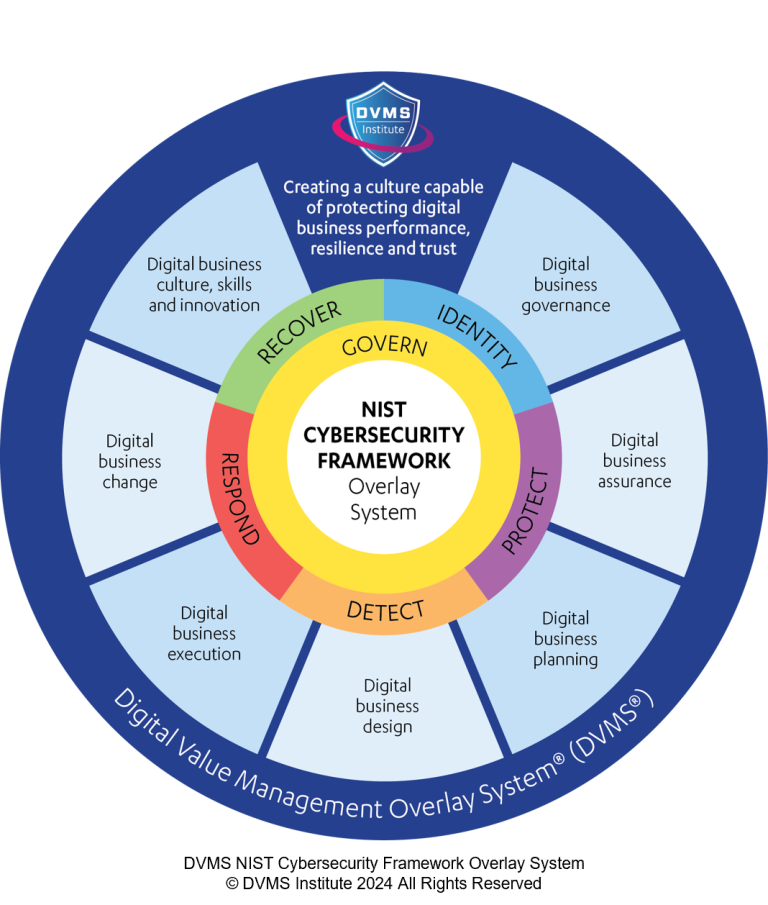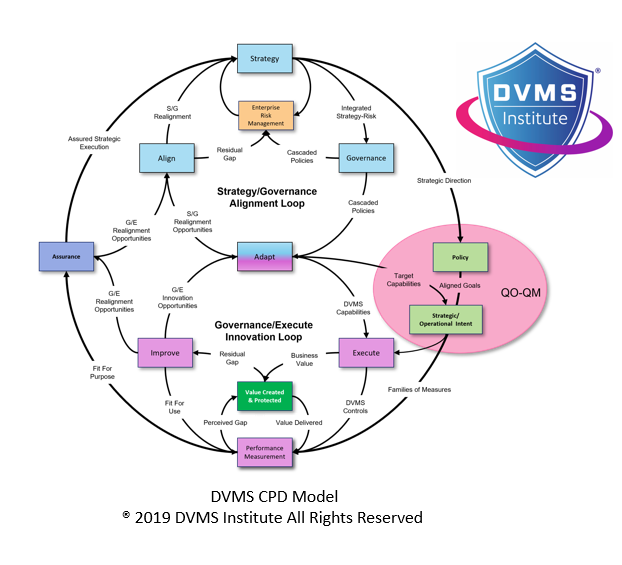The NIST Cybersecurity Framework Digital Value Management System: A Holistic and Culture-Aligned Overlay System for Cyber Operational Resilience
Rick Lemieux – Co-Founder and Chief Product Officer of the DVMS Institute
Introduction
In an age of relentless digital disruption and increasingly complex cyber threats, private sector companies and public institutions must evolve beyond compliance-based security programs and adopt resilient, adaptive systems capable of delivering value securely and consistently.
The combination of the NIST Cybersecurity Framework (CSF) 2.0 and the Digital Value Management System® (DVMS) represents exactly this next-generation solution. By uniting outcome-based cybersecurity governance with systems thinking and value assurance, this integrated model offers a robust and universally adaptable cyber resilience operating system, critical for any organization seeking to thrive in the digital economy.
NIST Cybersecurity Framework 2.0.
The NIST CSF 2.0 is a globally recognized framework that provides high-level, outcome-oriented guidance to help organizations understand, manage, and reduce cybersecurity risk. It is structured around six core Functions—Govern, Identify, Protect, Detect, Respond, and Recover—that support a comprehensive, lifecycle approach to cybersecurity. However, while the CSF articulates “what” outcomes organizations should achieve, it leaves the question of “how” to accomplish them in real operational, strategic, and cultural environments. This is where the Digital Value Management System plays a vital role.
Digital Value Management System®
The DVMS is not another control framework or checklist. It is an overlay system designed to embed cybersecurity and digital value protection directly into the governance and operations of any enterprise—commercial, governmental, or hybrid. It introduces seven Minimum Viable Capabilities (MVCs)—Govern, Assure, Plan, Design, Change, Execute, and Innovate—that can be adapted to any sector, scale, or maturity level. These capabilities map directly onto the CSF outcomes, creating a scalable and repeatable system for implementing, governing, and continuously improving cybersecurity to align with strategic business and public sector goals.
For companies, this model enables cybersecurity transformation from a cost center or compliance requirement into a value-creating asset. Trust, availability, and data integrity are essential to customer loyalty and competitive advantage in the private sector. By implementing the DVMS with the NIST CSF, businesses can build cybersecurity and resilience into their core business processes—from supply chain logistics to digital product design—ensuring that the value they create is delivered, protected, and sustained over time.
Conversely, governments face increasing demands for transparency, accountability, and secure digital service delivery. Whether managing health systems, critical infrastructure, or citizen-facing platforms, the risks governments face are amplified by geopolitical instability, cybercrime, and regulatory complexity. The CSF + DVMS solution helps public institutions move beyond fragmented, compliance-heavy security models toward a more unified and mission-aligned digital trust system. It supports policy alignment, cross-agency collaboration, and continuous improvement, while enabling governments to maintain sovereignty over implementing national and regional cybersecurity strategies.
A central pillar of this integrated system is the CPD Model—Create, Protect, Deliver. This model reinforces the idea that creating value without protection is unsustainable, and protecting value without delivering it undermines the organizational very mission. In companies, this ensures that security is embedded into digital transformation efforts, innovation labs, and customer experiences. In government, it ensures that public value, such as access to health services or digital IDs, is created and maintained in a secure, resilient, and trusted way. The CPD Model introduces a feedback loop mindset, making cybersecurity not a gatekeeper but a strategic enabler of innovation and delivery.
The DVMS feedback loops—including the Governance/Execution Loop, the Strategy/Governance Loop, and the Execution/Innovation Loop—ensure that information flows bidirectionally between executive leadership, operational teams, and innovation functions. This structure helps break down the silos that often cause misalignment between strategy and execution. For example, a company’s board might approve a digital expansion strategy without fully appreciating its cyber risk implications; a DVMS-driven system ensures that risk is surfaced, quantified, and factored into every phase of planning and execution. For government agencies, it ensures that digital modernization programs remain within risk tolerance while meeting service-level expectations from the public.
Another foundational concept of the DVMS is the 3D Knowledge Model, which encourages organizations to map their knowledge along three axes: time (past, present, and future), collaboration (across teams and disciplines), and alignment (with strategic intent). This model helps build organizational intelligence, enabling stakeholders to make better decisions faster by accessing the proper knowledge at the right time. Whether a private company is coordinating global product launches or a government is managing disaster response, this model ensures that the right actors can access actionable intelligence.
A major benefit of adopting the CSF + DVMS system is the ability to measure what matters. Most cybersecurity programs track incident counts, compliance checkboxes, or patch rates. While important, these metrics rarely capture cybersecurity programs’ true resilience or effectiveness. The DVMS integrates proven measurement models such as Goal-Question-Metric (GQM) and Question-Outcome–Question Metric (QO–QM) to tie security performance directly to business and mission outcomes. For a financial services company, this might mean linking cybersecurity controls to reduced fraud losses or improved customer retention. For a government, it could mean showing how risk-informed governance improves digital inclusion or citizen satisfaction.
Another area where the DVMS shines is its ability to support cultural transformation. Both companies and governments often face resistance to change, especially when cybersecurity is perceived as complex, punitive, or overly technical. The DVMS provides a cultural roadmap, showing how governance, assurance, and innovation can be aligned with organizational purpose. This encourages shared accountability and a shift from reactive behavior to proactive resilience. A security-aware culture becomes not just the responsibility of IT but a shared enterprise capability.
Furthermore, the DVMS’s overlay nature makes it extremely practical. Organizations don’t have to abandon existing frameworks like ISO 27001, COBIT, or ITIL. Instead, the DVMS overlays them, filling gaps, exposing redundancies, and creating coherence between disparate policies, procedures, and platforms. This reduces waste, simplifies audit and compliance reporting, and ensures that cybersecurity is aligned across departments, geographies, and strategic initiatives.
Finally, the NIST CSF + DVMS helps public and private organizations build a narrative of trust and resilience. In a world where customers, citizens, investors, and regulators demand performance and transparency, this integrated system provides the language, tools, and measures to demonstrate that cybersecurity is not just an afterthought. It is built into the mission, governed like any other business risk, and improved continuously through feedback, learning, and innovation.
Conclusion
Whether for a fast-growing startup, a global enterprise, a healthcare provider, or a national government, the NIST Cybersecurity Framework Digital Value Management System offers a complete, scalable, and transformative approach to cybersecurity and resilience. It provides a shared vocabulary, a systems architecture, and a cultural model connecting strategic value creation and technical risk protection. In a digital world of opportunity and uncertainty, the CSF + DVMS combination is not simply a tool but the operating system for secure, sustainable, and high-trust digital value and operational resilience.
About the Author

Rick Lemieux
Co-Founder and Chief Product Officer of the DVMS Institute
DVMS Institute is a renowned provider of accredited (APMG International), Assured (NCSC-GCHQ-UK), and Recognized (DHS-CISA-NICCS-USA) NIST Cybersecurity Framework, Digital Value Management System® body of knowledge publications, certification trainings, assessment platforms and real-life desktop simulation trainings.
The Institute’s NIST Cybersecurity Framework Digital Value Management System® certified training programs teach businesses of any size, scale, or complexity the skills to build a Holistic, Adaptive, and Culture-Powered Overlay System capable of anticipating and mitigating the systemic risk that will impact organizational cyber resilience.
By embedding systemic risk management into strategic decision-making and aligning it with employee cultural values, organizations can build resilience—a dynamic capability to withstand digital business disruption and comply with any cybersecurity regulation (SEC, UK, DORA, NIS2, SAMA, SOCI, IMO, etc.) or maturity model mandates (HITRUST, CMMC, C2M2 etc.).
® DVMS Institute 2024 All Rights Reserved



